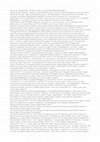Papers by Yogesh Upadhyay

Journal of Business Research, 2023
As a result of digitalization, consumers have more agency than in earlier times. Consumers now ha... more As a result of digitalization, consumers have more agency than in earlier times. Consumers now have the ability to express their consumption experiences through diverse online platforms by means of rating or providing written feedback. The ability to effectively decipher online customer reviews (OCRs) holds significant importance for businesses due to its far-reaching consequences. This research aimed to determine if review valence (RV) (the degree to which reviews are extremely positive or negative) was transmitted to purchase intentions via review helpfulness within the framework of signaling theory and cue-diagnosticity theory. The research also examined the presence of negative bias among customers when evaluating the valence of online customer reviews (OCRs) and its signaling ofreview helpfulness. Further, to determine if such an effect occurs within the boundaries of brand equity, an experimental study was conducted sequentially on two products: mobile phones and laptop computers. The study did not find negative bias among consumers concerning the assessment of RV. Further, the study supports an indirect effect of RV on purchase intention through review helpfulness. In addition, the results demonstrate that the referred effect is fully mediated by review helpfulness. Moreover, the results indicate that such an indirect effect is contingent on the brand's equity. The findings indicate that the RV has a significant effect on purchase intentions, particularly when brand equity is low. The study also discusses its managerial and research implications.
JIMS8M The Journal of Indian Management & Strategy, 2021

Journal of Consumer Behaviour, 2022
It has been a challenge to map the efficacy of marketing communications in building stronger bran... more It has been a challenge to map the efficacy of marketing communications in building stronger brands on social media. Given the paucity of research in this area, the present study offers a holistic model that maps the effect of social media marketing (hereinafter SMMEs) on consumer response via building brand equity and brand trust. This study was conducted on customers of major brands of smartphones in India. The data were collected from 318 consumers who visited fan pages of the selected brands of smartphones. The current study examines how SMMEs influence customer behavior via brand equity and trust. Additionally, the study examines how brand equity and brand trust interact during the process. The current study's findings indicate that brand equity partially mediates the effect of SMMEs on customer response. On the other hand, SMMEs do not succeed in converting brand trust into customer response. Further, brand equity fully mediates SMMEs' effect on brand trust. Finally, the results also show that the effect of brand equity on customer response is partially mediated by brand trust. Toward the end, study dwells on its practical implications and limitations.

RAUSP Management Journal, 2021
Purpose In the backdrop of job demands-resources model, the purpose of this paper is to investiga... more Purpose In the backdrop of job demands-resources model, the purpose of this paper is to investigate the effect of selected job resources (job autonomy and rewards and recognition) and job demands (problem with work) on innovative work behaviour through the mediation of employee engagement in the higher education sector of India. Design/methodology/approach The sample consists of randomly selected 275 teachers from higher education institutions from a city in India. This study used PLS-SEM for data analysis. Findings The results suggest that employee engagement associates closely with innovative work behaviour. Job autonomy, one of the resources, affects innovative work behaviour directly and its effect does not move via employee engagement. Further, reward and recognition does not impact innovative work behaviour directly, rather, its effect moves through employee engagement. Finally, the work suggests that employee engagement mediates between selected job resources and job demands ...

N the last two decades, Information Technology has played a key role in transforming the way busi... more N the last two decades, Information Technology has played a key role in transforming the way business is conducted. With each new wave of technology, it has brought about fundamental changes. In all these, the one technology that has truly been an effective agent in changing the fundamental ways of doing business is none other than ubiquitous thing that everyone knows as Internet (Hindustan Times 1998). The Perfect Competition Adam Smith himself recognised that the virtues of market mechanism are fully realised when the checks and balances of perfect competition are present (Samuelson 1992). Perfect competition refers to a market in which no firm or consumer is effective enough to affect the market price. The firms are usually price takers. The buyer is aware of the prevailing prices in the market. The entry and exit of firms have least effect on the market. Till now, perfect competition was considered to be a myth. But the advent of Internet, has made it a reality. The geographical boundaries are eroding rapidly for the purpose of business with the spread of Internet. The implication is that the sellers or buyers which due to their number or capacity were able to affect the price earlier can not do so now. It is not a single country where buyers and firms are spread. They are spread across the globe. Therefore, the number of such firms and buyers are minuscule in proportion which can have impact on globally prevalent prices. The firms are also free to enter and exit from the market place.

International Journal of Hospitality Management, 2022
Continuous innovation is what helps companies survive the highly discontinuous competition. Secur... more Continuous innovation is what helps companies survive the highly discontinuous competition. Securing innovative work behaviour from employees has drawn the attention of businesses and researchers alike. The current work draws on broaden-and-build theory and goal orientation theory to propose how an individual’s psychological capital, which is malleable, helps in achieving innovative work behaviour from employees. The study has been conducted in the context of three-star hotels located in and around New Delhi, the capital of India. The data was collected using standard scales from a dyad of 229 employees and their managers. The present study enriches the innovative work behavior literature by combining different perspectives in a coherent framework and demonstrates the partially mediated positive relationship of psychological capital and innovative work behavior via mastery orientation. Also, the study reveals that the partially mediated indirect effect varies among employees based on their level of CSE.

South Asian journal of management, 2015
Higher education sector in India has witnessed a rapid growth in the past few years. The number o... more Higher education sector in India has witnessed a rapid growth in the past few years. The number of private universities is increasing and so is the intensity of competition in the higher education sector. Scholars in the past have linked market orientation with organizational performance. This paper aims at examining the market orientation-performance relationship in private universities of India. The study also examines the moderating effect of competition intensity on the market orientation and performance relationship. Results of the study confirmed the presence of a positive relationship between market orientation and economic performance. The study not only explored economic performance but also examined the effect of market orientation on students' and research performance of the universities. The results of the study indicated that the intensity of the competition affects the proposed relationship between market orientation and performance in private universities. Implica...
Journal of Management and Research, 2018

Journal of Advances in Management Research, 2021
PurposeDue to wider acceptance of information technology (IT) and e-commerce among the consumers,... more PurposeDue to wider acceptance of information technology (IT) and e-commerce among the consumers, firms belonging to agri businesses are rapidly redefining IT-driven stakeholders' centric completive strategy for their supply chain. This has forced the firms to understand the stakeholders' information needs and quality they expect from the electronic supply chains. Thus, the present study focusses on developing an information quality framework that ensures the success of stakeholders' centric e-agri supply chain. The study also attempts to investigate the interrelationship between formative endogenous latent variables, i.e. value of information (VoI), e-platform responsiveness (RESP), e-platform aesthetics (SAE), e-platform ease of use (EoU) and fulfillment of expectation (FoE) used in the developing the proposed framework.Design/methodology/approachSurvey based data are obtained from 280 respondents using semistructured questionnaire to validate the proposed theoretical ...

Prabandhan: Indian Journal of Management, 2014
Even if evaluated at an organizational level, a market-oriented culture of an organization is gen... more Even if evaluated at an organizational level, a market-oriented culture of an organization is genuinely supported by the outlooks and activities of the organization's employees. A market orientation strategy cannot be developed without every employee's active understanding, willingness, and ability to perform in market-oriented methods. Consequently, an individual employee must be familiar with the task of gathering and assessing the value of market information, and also, he should be willing to share it with other employees. We surveyed a variety of employees at many levels and roles in different central Indian financial services organizations. This research identifies the important individual-level antecedents and consequences that organizations should account for once making an attempt to stimulate company-wide market-oriented behaviours. These embrace the fostering psychological contracts, modelling of learning methods by agile learners, inflated opportunities, and time to develop personal ties between customers and workers in numerous roles at intervals in the firm.
Journal of Advances in Management Research, 2021
RAUSP Management Journal, 2021

International Journal of Hospitality Management, 2022
Continuous innovation is what helps companies survive the highly discontinuous competition. Secur... more Continuous innovation is what helps companies survive the highly discontinuous competition. Securing innovative work behaviour from employees has drawn the attention of businesses and researchers alike. The current
work draws on broaden-and-build theory and goal orientation theory to propose how an individual’s psychological
capital, which is malleable, helps in achieving innovative work behaviour from employees. The study has
been conducted in the context of three-star hotels located in and around New Delhi, the capital of India. The data
was collected using standard scales from a dyad of 229 employees and their managers. The present study enriches
the innovative work behavior literature by combining different perspectives in a coherent framework and
demonstrates the partially mediated positive relationship of psychological capital and innovative work behavior
via mastery orientation. Also, the study reveals that the partially mediated indirect effect varies among employees
based on their level of CSE.

Journal of Consumer Behaviour, 2022
It has been a challenge to map the efficacy of marketing communications in building stronger bran... more It has been a challenge to map the efficacy of marketing communications in building stronger brands on social media. Given the paucity of research in this area, the present study offers a holistic model that maps the effect of social media marketing (hereinafter SMMEs) on consumer response via building brand equity and brand trust. This study was conducted on customers of major brands of smartphones in India. The data were
collected from 318 consumers who visited fan pages of the selected brands of smartphones. The current study examines how SMMEs influence customer behavior via brand equity and trust. Additionally, the study examines how brand equity and brand trust interact during the process. The current study's findings indicate that brand equity
partially mediates the effect of SMMEs on customer response. On the other hand, SMMEs do not succeed in converting brand trust into customer response. Further, brand equity fully mediates SMMEs' effect on brand trust. Finally, the results also show that the effect of brand equity on customer response is partially mediated by brand trust. Toward the end, study dwells on its practical implications and limitations.
N the last two decades, Information Technology has played a key role in transforming the way busi... more N the last two decades, Information Technology has played a key role in transforming the way business is conducted. With each new wave of technology, it has brought about fundamental changes. In all these, the one technology that has truly been an effective agent in changing the fundamental ways of doing business is none other than ubiquitous thing that everyone knows as Internet (Hindustan Times 1998).
International Journal of Business and Emerging Markets
Vision: The Journal of Business Perspective
The present study examines the mediation of employees’ psychological capital (PsyCap) on the infl... more The present study examines the mediation of employees’ psychological capital (PsyCap) on the influence of leader–member exchange (LMX) on creativity of employees. We collected data from dyads of 70 supervisors and 280 employees to investigate the hypothesized linkages. The results suggest that PsyCap partially mediates the influence of LMX on employees’ creativity. Also, the effect of LMX and PsyCap on employees’ creativity is significant. Finally, high-quality LMX is significantly related to high PsyCap. Implications of the outcome for researchers and practicing managers are also discussed.
International Journal of Business and Globalisation











Uploads
Papers by Yogesh Upadhyay
work draws on broaden-and-build theory and goal orientation theory to propose how an individual’s psychological
capital, which is malleable, helps in achieving innovative work behaviour from employees. The study has
been conducted in the context of three-star hotels located in and around New Delhi, the capital of India. The data
was collected using standard scales from a dyad of 229 employees and their managers. The present study enriches
the innovative work behavior literature by combining different perspectives in a coherent framework and
demonstrates the partially mediated positive relationship of psychological capital and innovative work behavior
via mastery orientation. Also, the study reveals that the partially mediated indirect effect varies among employees
based on their level of CSE.
collected from 318 consumers who visited fan pages of the selected brands of smartphones. The current study examines how SMMEs influence customer behavior via brand equity and trust. Additionally, the study examines how brand equity and brand trust interact during the process. The current study's findings indicate that brand equity
partially mediates the effect of SMMEs on customer response. On the other hand, SMMEs do not succeed in converting brand trust into customer response. Further, brand equity fully mediates SMMEs' effect on brand trust. Finally, the results also show that the effect of brand equity on customer response is partially mediated by brand trust. Toward the end, study dwells on its practical implications and limitations.
work draws on broaden-and-build theory and goal orientation theory to propose how an individual’s psychological
capital, which is malleable, helps in achieving innovative work behaviour from employees. The study has
been conducted in the context of three-star hotels located in and around New Delhi, the capital of India. The data
was collected using standard scales from a dyad of 229 employees and their managers. The present study enriches
the innovative work behavior literature by combining different perspectives in a coherent framework and
demonstrates the partially mediated positive relationship of psychological capital and innovative work behavior
via mastery orientation. Also, the study reveals that the partially mediated indirect effect varies among employees
based on their level of CSE.
collected from 318 consumers who visited fan pages of the selected brands of smartphones. The current study examines how SMMEs influence customer behavior via brand equity and trust. Additionally, the study examines how brand equity and brand trust interact during the process. The current study's findings indicate that brand equity
partially mediates the effect of SMMEs on customer response. On the other hand, SMMEs do not succeed in converting brand trust into customer response. Further, brand equity fully mediates SMMEs' effect on brand trust. Finally, the results also show that the effect of brand equity on customer response is partially mediated by brand trust. Toward the end, study dwells on its practical implications and limitations.